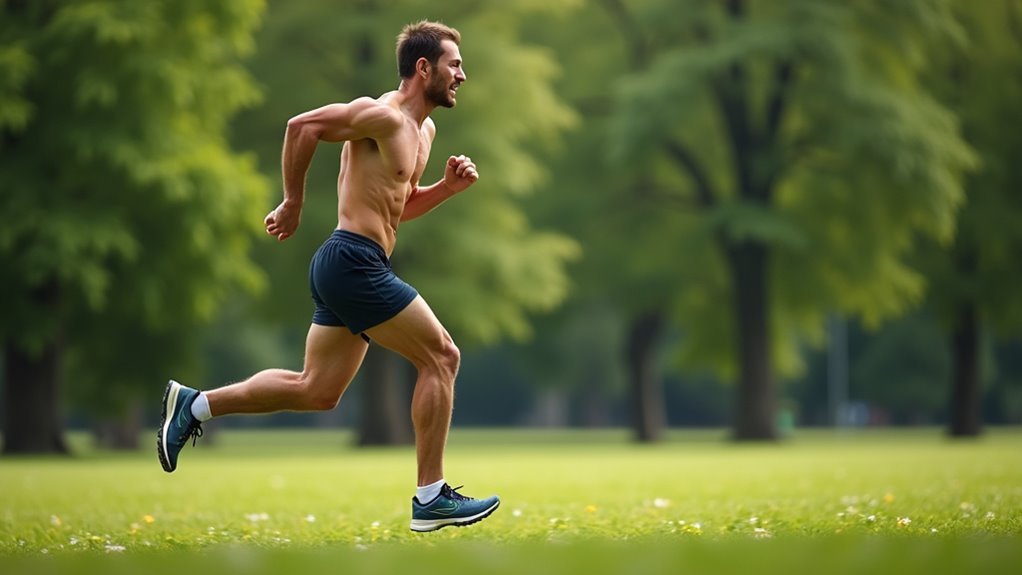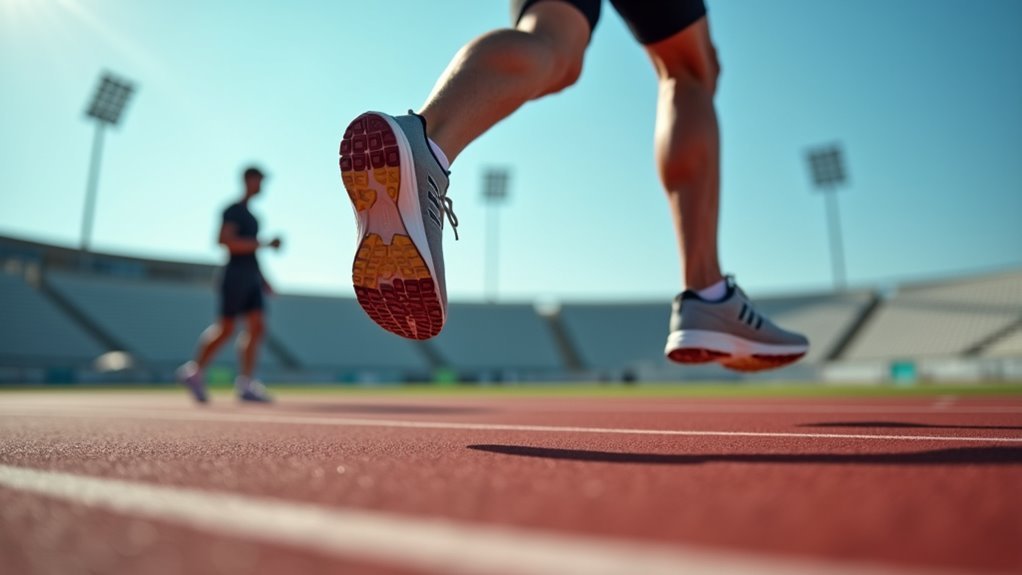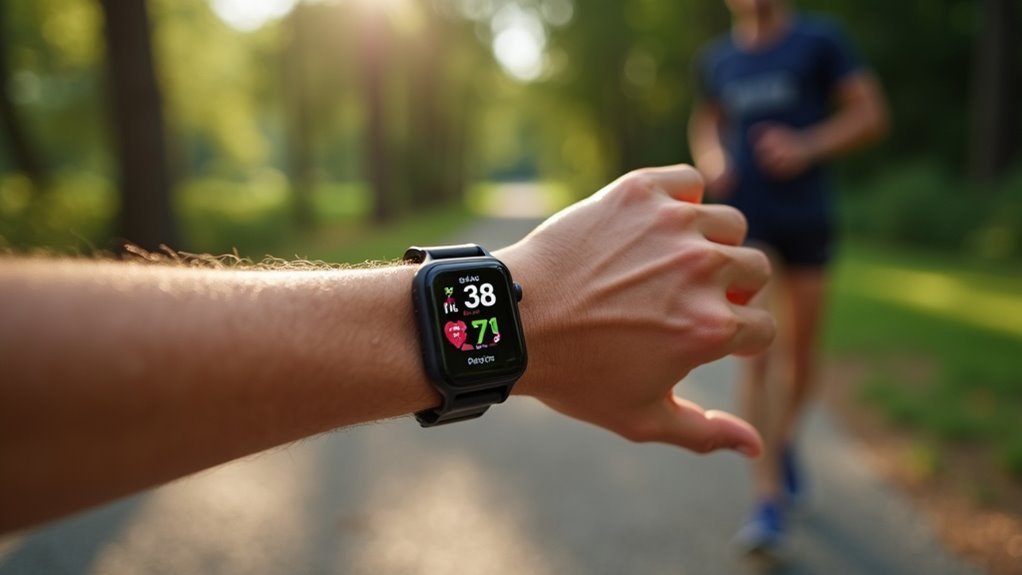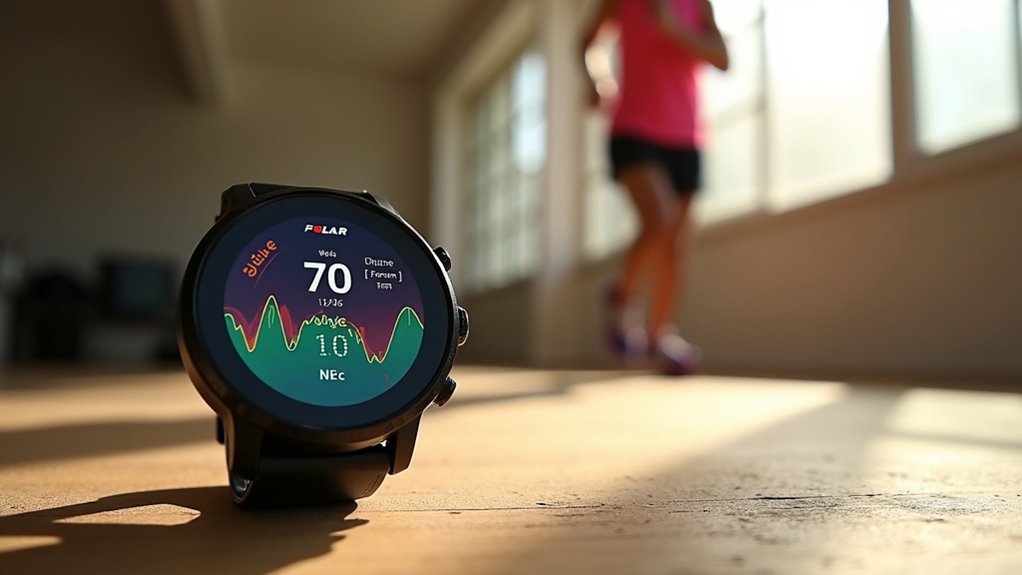Reducing your running bounce height dramatically improves your energy efficiency by converting wasted vertical motion into horizontal propulsion. You’ll experience less joint impact stress, faster ground contact times, and better running economy. Excessive bounce wastes precious energy that could propel you forward, while ideal vertical oscillation below 5cm helps prevent injuries to your knees, ankles, and hips. Mastering this technique reveals significant performance gains and thorough biomechanical improvements.
Understanding Vertical Oscillation in Running Biomechanics

When you run, your body naturally moves up and down with each stride, creating what biomechanics experts call vertical oscillation (VO). This measurement captures the distance between your highest and lowest body positions during each running cycle, typically ranging from 5-10 centimeters for most runners.
While some vertical movement is necessary for generating forward propulsion, excessive bounce indicates inefficiency. You’re fundamentally wasting energy on upward motion instead of channeling it into forward momentum. Your VO reflects how effectively you’re converting muscle power into horizontal speed.
Several factors influence your bounce height, including stride force, forward lean, running speed, and terrain. High vertical oscillation can also increase impact force upon ground contact, potentially raising your risk of stress-related injuries. Understanding these biomechanical principles helps you identify why your running form might be less efficient than ideal.
Energy Efficiency Gains From Reduced Bounce Height
Because excessive vertical movement wastes precious energy that could propel you forward, reducing your bounce height delivers measurable efficiency gains that compound over distance.
When you minimize vertical oscillation, you’re converting kinetic energy into forward momentum rather than losing it through unnecessary upward motion.
Here’s how reduced bounce height maximizes your energy efficiency:
- Direct Energy Transfer – You channel more power into horizontal propulsion instead of fighting gravity.
- Reduced Ground Contact Time – Shorter contact phases mean less energy dissipation with each footstrike.
- Optimized Muscle Utilization – Your muscles work more efficiently without excessive vertical force production.
- Cumulative Savings – Small efficiency gains multiply exponentially over longer distances, delaying fatigue.
This biomechanical optimization transforms wasted vertical energy into sustained forward progress. The principles of momentum conservation demonstrate that energy not lost to vertical bouncing remains available for forward propulsion.
Injury Prevention Through Optimal Vertical Movement

When you reduce your running bounce height, you’ll dramatically decrease the impact forces that slam into your joints with every footstrike.
You’re fundamentally managing the ground reaction forces more effectively, which translates to less stress on your knees, ankles, and hips throughout your run.
This ideal vertical movement pattern doesn’t just feel better—it’s actively preventing the biomechanical stress that leads to common running injuries. However, relying on a single biomechanical measure like bounce height is insufficient, as running injuries involve multiple contributing factors including training volume, genetics, and other complex variables.
Joint Impact Reduction
Although joint impact during running creates significant stress throughout your body’s kinetic chain, you can dramatically reduce these forces by optimizing your vertical movement patterns.
When you minimize excessive bounce, you’ll distribute ground reaction forces more efficiently across your joints, preventing concentrated loading that leads to overuse injuries.
Your foot strike technique directly influences where impact occurs. Here’s how to reduce joint stress:
- Increase your step rate to decrease vertical excursion and braking impulse
- Shorten your stride length to minimize vertical body displacement during each step
- Strengthen muscles around key joints to provide additional support against excessive loading
- Gradually adapt your technique to give joints time to adjust to new movement patterns
This systematic approach helps you maintain running longevity while protecting vulnerable areas like your knees and ankles. Efficient counter-rotation between your upper and lower body enables continuous force flow throughout your kinetic chain, preventing force concentration that can overwhelm individual joints during counter-rotation.
Ground Force Management
Master your ground reaction forces, and you’ll transform how efficiently your body interacts with each running surface.
When you enhance vertical movement control, you’re reducing bounce height and creating more consistent oscillation patterns that sustain your speed longer. This efficient ground contact allows smoother changes from stance to swing phase while increasing your stride frequency.
You’ll also greatly reduce stress on your joints and lower your risk of overuse injuries. Poor ground force management creates common injury patterns that biomechanical assessment tools can identify through force platform analysis. Runners should focus on body weight distribution rather than increasing leg speed when working to optimize their ground contact mechanics.
Biomechanical Stress Prevention
Since excessive vertical oscillation places tremendous stress on your ankles, knees, and hips, you’re fundamentally creating a recipe for overuse injuries with every bounce.
Each excessive vertical movement forces these joints to absorb unnecessary impact forces, accelerating wear and tear throughout your lower limbs.
Reducing your bounce height creates a protective biomechanical shield through four key mechanisms:
- Distributed Load Management – Lower oscillation spreads stress more evenly across your joint systems
- Reduced Impact Forces – Minimized vertical displacement decreases the force your joints must absorb
- Improved Shank Positioning – Maintaining perpendicular shank position during foot contact reduces joint strain
- Enhanced Support Moments – Optimized ankle, knee, and hip extensor coordination manages stress more effectively
You’re basically engineering injury prevention into every stride. This efficiency principle becomes especially critical when you redirect energy from wasteful bounce into forward motion, maximizing your propulsion while simultaneously protecting your body.
Performance Metrics and Smartwatch Data Analysis

While traditional coaching methods rely on visual observation and subjective feedback, modern smartwatches transform how you measure and improve your running bounce.
Devices like COROS, Garmin, and Polar track your vertical oscillation in real-time, measuring stride height as vertical displacement per step. You’ll see ideal performance when your stride height stays below 5 cm, indicating efficient energy use.
Modern smartwatches measure your vertical bounce in real-time, with efficient runners maintaining stride height below 5 centimeters per step.
Your smartwatch calculates stride ratio by dividing stride height by stride length. You’re running efficiently when this ratio stays below 6%, while ratios exceeding 12% signal poor form.
Color-coded feedback shows whether you’re in ideal, good, or poor zones.
These devices also monitor left/right balance, alerting you when imbalance exceeds 51.5% on either side, which increases injury risk and correlates with excessive bounce patterns. Advanced runners demonstrate significantly shorter ground contact time, with elite athletes achieving as low as 180ms compared to the 270-300ms range typical for average runners.
Practical Techniques for Minimizing Excessive Bounce
You can considerably reduce your running bounce through targeted cadence adjustments and proper form modifications.
Increasing your step rate to around 180 steps per minute while maintaining a forward lean naturally shortens your stride and minimizes vertical oscillation.
Additionally, incorporating specific strength training exercises will develop the neuromuscular control needed to maintain these efficiency improvements consistently. Behavioral analysis of your running patterns can help identify specific bounce issues that need correction.
Cadence and Form Adjustments
When excessive bounce undermines your running efficiency, targeted adjustments to cadence and form can dramatically reduce vertical oscillation while improving forward propulsion.
You’ll want to focus on increasing your turnover to around 180 steps per minute, which naturally shortens your stride and decreases ground contact time.
Key adjustments include:
- Maintain upright posture – Keep your chest lifted and lean forward from your ankles, not your waist.
- Land closer to your center – Avoid overstriding by placing your feet beneath your hips rather than far ahead.
- Engage your core – Stabilize your pelvis to minimize unnecessary upper body movement.
- Emphasize quick, light footstrikes – Focus on rapid turnover with minimal ground contact.
These changes’ll help you glide forward efficiently rather than bouncing upward wastefully. Proper timing of push-off during each stride cycle prevents excessive vertical movement and channels your energy into forward momentum.
Strength Training Benefits
Building strength in key muscle groups transforms your running mechanics from the ground up, directly targeting the biomechanical issues that create excessive bounce. You’ll see the most significant improvements through targeted lower limb strengthening, particularly ankle, foot, and hip muscles. This approach reduces excessive foot motion at heel strike while lowering hip internal rotation and knee abduction moments.
| Training Type | Key Exercises | Primary Benefits |
|---|---|---|
| Lower Limb | Isokinetic eversion/inversion, squats | Reduces foot motion, improves joint alignment |
| Plyometric | Bounding, jumping split squats | Develops elastic energy storage, shorter ground contact |
| Neuromuscular | Feedback-guided hip strengthening | Corrects hip adduction, reduces ground reaction forces |
| Power Development | Direction change drills | Controls landing forces, reduces upward momentum |
| Heavy Resistance | Low-rep, high-load exercises | Maximizes strength gains for running mechanics |
You’ll achieve measurable improvements within 6-10 weeks when combining these approaches. The enhanced muscular endurance developed through consistent strength training allows you to maintain proper form throughout longer runs, preventing the biomechanical breakdown that leads to increased bounce height as fatigue sets in.
Training Methods and Running Form Improvements
Since excessive vertical oscillation wastes energy and increases injury risk, implementing specific drills and form adjustments becomes essential for developing efficient running mechanics.
You’ll need to focus on maintaining a slight forward lean while increasing your cadence to minimize airtime. Practice keeping your head stable and engage your core to reduce unnecessary vertical movement. Aim for an optimal ankle angle of 15-17 degrees to enhance your running efficiency.
Key training methods include:
- Fall to Run drills – Promote forward momentum instead of vertical lift through controlled take-off angles
- Fast-feet exercises – Develop quick, light steps that maintain ground contact efficiency
- Cadence training – Gradually increase step frequency to reduce bounce and improve rhythm control
- Video analysis feedback – Monitor your form using technology to track oscillation improvements over time
These techniques help you conserve energy and reduce injury risk.
Long-term Benefits of Optimized Running Mechanics
After integrating proper running mechanics into your training routine, you’ll experience transformative benefits that extend far beyond immediate performance gains.
Your optimized form will preserve joint and muscle function throughout your entire running career while reducing cumulative impact stress on your spine and lower limbs. You’ll maintain quality training sessions with less fatigue accumulation, enabling consistent performance progression over time.
Efficient mechanics decrease your injury risk considerably, preventing overuse injuries like shin splints and IT band syndrome. This translates to fewer missed training days and sustained training volumes without increased injury risk. Gradual increase in training volume is crucial for longevity, and incorporating strength training and flexibility exercises reduces injury risk.
Your improved running economy allows faster paces at the same perceived effort, maximizing your long-term endurance potential while promoting healthy aging and running longevity.
Frequently Asked Questions
Does Shoe Type Affect Vertical Oscillation and Bounce Height Reduction?
Shoe type affects your vertical oscillation differently depending on your individual biomechanics. Higher stack height shoes often increase your bounce height, while some advanced foam technologies can reduce it through better energy return.
How Long Does It Take to See Results From Bounce Reduction Training?
You’ll notice improved running form within 4-8 weeks of consistent bounce reduction training. Muscle memory develops in 6-12 weeks, while significant strength gains take 8-12 weeks to maximize your energy efficiency.
Can Tall Runners Achieve the Same Bounce Reduction as Shorter Runners?
You can achieve significant bounce reduction regardless of your height, though you’ll face unique challenges. Focus on shorter strides, higher cadence, and tailored drills to overcome your longer limbs and higher center of gravity.
What’s the Difference Between Bounce Height on Trails Versus Road Surfaces?
You’ll experience lower bounce height on trails due to softer, uneven surfaces that naturally absorb impact. Roads create higher bounce from hard, predictable surfaces that return more energy with each footstrike.
Are There Age-Related Factors That Impact Vertical Oscillation Control Ability?
As you age, you’ll experience decreased muscle strength and flexibility that affects your vertical oscillation control. Your biomechanics change, making it harder to maintain efficient bounce height and increasing injury risk.
In Summary
You’ll transform your running by reducing bounce height, gaining immediate energy efficiency and long-term injury prevention. Your smartwatch data will show improved metrics as you implement proper form techniques and training methods. You’re not just changing how you look while running—you’re optimizing your body’s mechanical efficiency. With consistent practice, you’ll develop sustainable running mechanics that’ll serve you for years. Start focusing on your vertical oscillation today, and you’ll feel the difference in every stride.





Leave a Reply